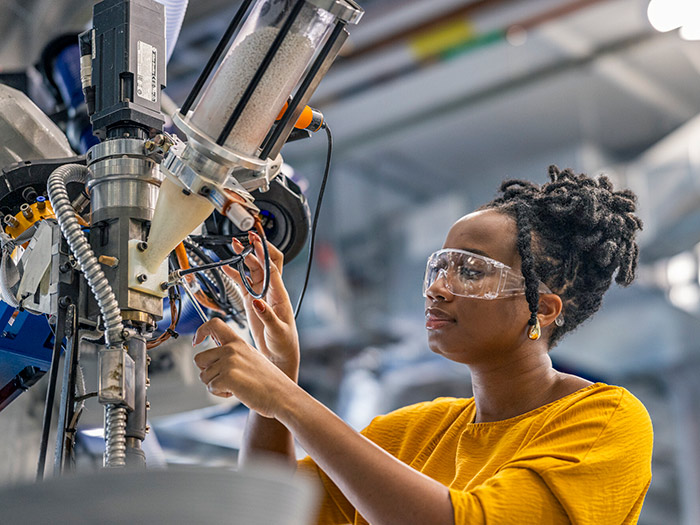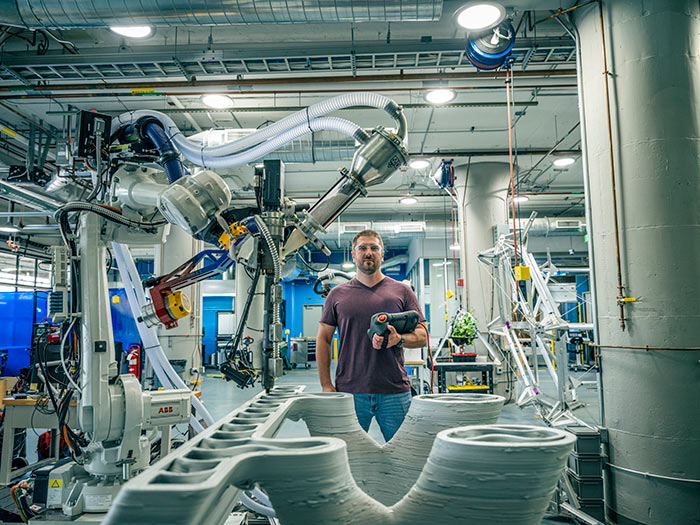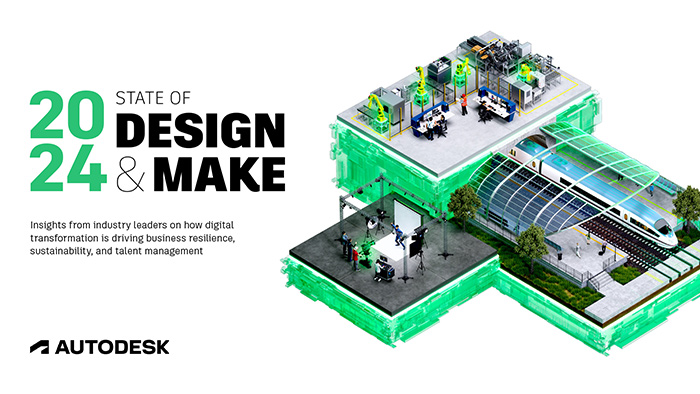While the effort to predict the future of work might seem both futile and overbearing, one thing is certain – AI is going to be a permanent addition to the organisational chart. According to this year’s State of Design & Make report commissioned by Autodesk, AI adoption is well underway, and out of over 450 Australian respondents from the Design and Make sectors – including architecture, engineering, construction, and operations (AECO) – almost 80% trust AI technologies. For now, AI adoption might be as simple as assisting with meeting notes transcription, but generative AI is starting to help us with making crucial design decisions about physical products, building layouts, digital assets and environmental outcomes.

The union of humans and machines
In essence, machines will be embedded into the workforce – and in the world where humans and AI are not only co-existing but thriving, the notion of deep collaboration between them emerges as a fundamental quality underpinning the future of work. What will that look like?
Autodesk is a global leader in the Design and Make industries, providing software for architects, builders, engineers, designers and manufacturers, and has been working in the AI space for over a decade. We recently sat down with Andy Cunningham, Autodesk’s Senior Regional Director for Australia and New Zealand, to understand what this changing relationship between humans and technology means for the industry.
“While AI won’t replace jobs, it will change them,” Cunningham says. He goes on to explain that AI will assist with automation of repetitive, administrative tasks, enhance and accelerate the creative process itself and enable predictive and better-informed decision-making. “It will improve efficiency, and free up people for more creative and skilled work. Like a bricklaying machine,” Cunningham offers. “In the construction industry for example, it won’t replace the bricklayer, but it will change their role. The machine may do the bricklaying but the bricklayers will still be required for human oversight and for roles such as layout and sequencing, which are equally as crucial.”
This simple example illustrates how AI shifts roles rather than eliminates them. “In this new paradigm, collaboration between humans and machines is essential,” Cunningham says. “While AI excels at tasks like automation and data analysis, the creative element remains uniquely human. AI empowers us to enhance, refine and accelerate this creativity, to make it more productive.”
Shifting roles and skill sets
The key is finding the right balance and connection between humans and technology – which will inevitably lead to a shift in skill sets. “Alongside soft skills, like adaptability and collaboration, this evolution is emphasising areas like programming and data analysis,” he says. Unsurprisingly, the State of Design & Make report confirms he is right on the money, and down under, where attracting and retaining talent is amongst the top challenges industries are currently facing, these capabilities are in high demand.
The study found that advanced skills working with BIM, modelling, or 3D design; software development; knowledge of data safety, data analytics and mining; as well as the ability to collaborate with AI; top the list of skills the study’s respondents will be looking for in new hires over the next couple of years. The respondents also clearly appreciate the importance of evolving skill sets – 71% of Australian respondents see upskilling as crucial.

The human yin to AI’s yang
“The ability to effectively collaborate with AI and embrace new ways of working will be crucial for success in the changing workplace,” Cunningham says. “Decision-making skills, adaptability, and a willingness to embrace non-linear workflows are crucial. As AI generates multiple design options, industry professionals need to be able to define requirements with precision, evaluate generated options critically and make informed decisions.”
The creativity, critical thinking and decision-making that humans bring to the table is the yin to AI’s robust yang – and Cunningham offers a real-life example of what this symbiotic collaboration can look like. A few years ago, Airbus used Autodesk AI to design a lighter, stronger partition for inside the aircraft. “The tool created not one or two but thousands of structural options for the partition,” he shares.
Apt at generating abundant options, AI won't make the final decision – this will still sit with an individual. Human oversight, and the ability to stay open to exploring various paths to then arrive at the right solution will be fundamental to successful collaborations.
Machine learning or learning machines?
The convergence of deep collaboration between humans and machines and shifting skill sets highlights the need for a holistic and systematic approach that requires involvement of governing bodies and educational facilities to ensure new skills generation happens before future industry professionals enter the workforce. Of course, it has to be overlaid with effective ways to upskill talent in the workforce right now – and everywhere and anywhere.
“Collaboration between government, industry, and solution providers like us is crucial to ensure accessible training at all levels, from universities to industry professionals nationwide,” Cunningham explains. “We're actively forming partnerships with other software providers and engaging with industry bodies like Engineers Australia and the Australian Institute of Architects to ensure our products meet the specific needs of the industry.” Autodesk has also established interoperability agreements with other software providers, such as Nemetschek, to optimise their customers’ workflows and help them generate better project outcomes. This collaborative approach is crucial for setting standards and ensuring seamless compatibility and integration between different technologies.
Autodesk offers numerous resources to help professionals stay ahead of the curve – starting with free licences for students and educators, granting them access to Autodesk’s technology for a year. Plus, there are learning modules, pathways, workflows, aiming to democratise access to these technologies and skill sets. “Our technical team creates bite-sized YouTube tutorials specifically for the Australian market,” Cunningham says.
“It's crucial to understand the current skill sets and recognise that jobs are evolving,” he adds. “The key is focusing on transferable skills, enabling portability and augmentation of existing expertise. On our part, we strive to make upskilling both accessible and affordable.”
Shifting skill set, evolving workplace
It’s not just the required skill set that’s evolving – the way we learn and work is changing too. “Gone are the days of week-long, out-of-office training sessions,” Cunningham says. “So now, we’re also integrating skill-building directly into our products. For instance, Autodesk Fusion can analyse user behaviour and offer personalised suggestions for improvement. This means learning happens in real time, at your desk or home office, rather than in a separate training environment.”
The State of Design & Make report indicates that in-product training and digital tools are already showing success on a global scale. For example, Autodesk’s anonymised AutoCAD data shows users are 35% more likely to learn a new command after seeing a personalised insight recommendation.

Cunningham refers to it as "shortening the distance of learning", and this way of approaching upskilling seems incredibly relevant in the context of the evolving workplace. As the report reveals, while 66% of companies might be mandating a return to the office, almost 67% are in fact seeking remote workers. This means that the ability to learn anytime and anywhere is a cornerstone of professional development in a hybrid workplace.
At the same time, enabling collaboration in a decentralised environment is crucial. Here, AI really shines too, helping individuals connect while embracing the flex-first model. “We've seen AI-powered, cloud-based collaboration platforms and well-organised project data enable teams to work effectively, even in a disconnected environment,” Cunningham confirms.
Stowe Australia, the country’s largest privately owned electrical and communications contractor, is in the process of unlocking these kinds of data-driven efficiency gains. Like many companies, it struggled with information silos created by manual processes, and unstructured, fragmented data that existed across its various units and functions.
The contractor needed a way to consolidate data and simplify knowledge management across the business – and it found that capability in Autodesk Construction Cloud. Since its recent rollout across all of Stowe’s branches, the company has already made significant efficiency gains by ensuring everyone has streamlined access to the latest data at the moment they need it – helping to reduce mistakes, save time, and foster better decision-making at all levels of the business.
Collaboration that unleashes creativity – and generative AI
Out of this confluence of shifting roles, new skill sets, organisational data hygiene and technological advancement emerges a collaborative and flexible workplace that capitalises on the immense potential of generative AI to truly unleash creative potential – and push the boundaries of design. From connecting project teams across different locations, augmenting design possibilities and introducing efficiencies throughout the process, the future of work powered by AI is a promising one – and defined by the symbiotic combination of human creativity with machine efficiency.
This collaboration leads to faster iterations, more refined designs, and ultimately, a more productive workflow that enables the industry to genuinely push the boundaries of innovation while solving the massive capacity problem. Generative AI is already sending ripples through the industry – bringing efficiency to urban planning, multi-level floor-plate design and even driving better sustainability outcomes. And this is just the beginning.

